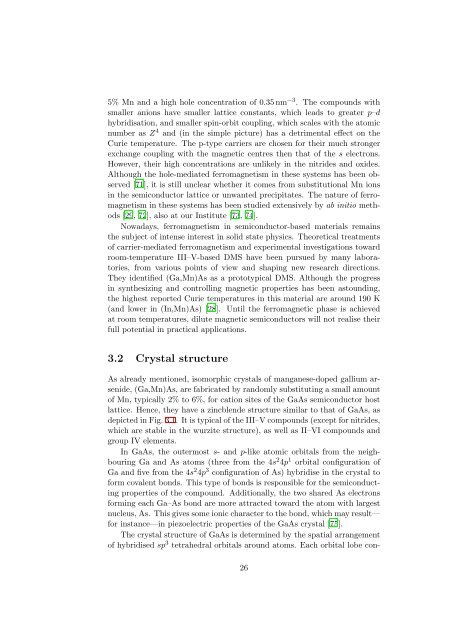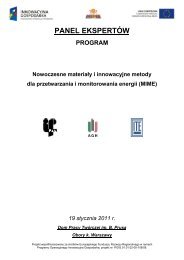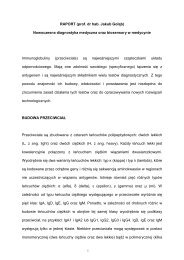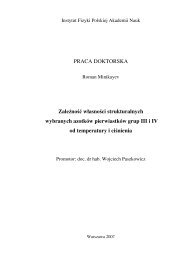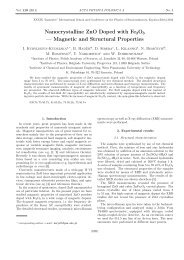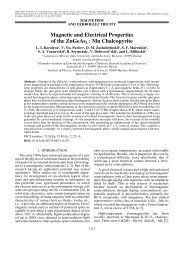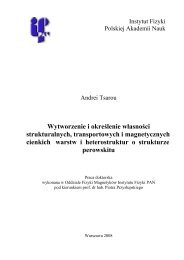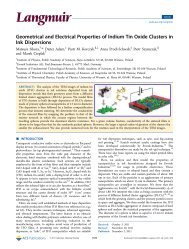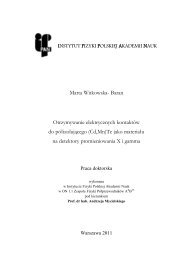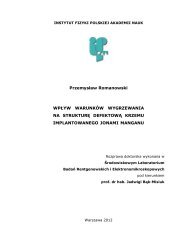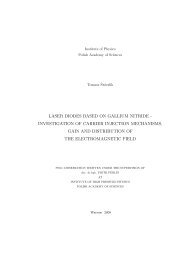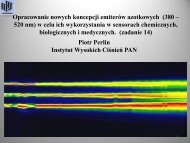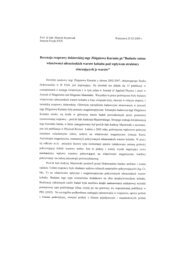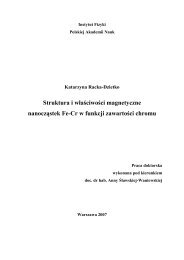Spin waves and the anomalous Hall effect in ferromagnetic (Ga,Mn)As
Spin waves and the anomalous Hall effect in ferromagnetic (Ga,Mn)As
Spin waves and the anomalous Hall effect in ferromagnetic (Ga,Mn)As
You also want an ePaper? Increase the reach of your titles
YUMPU automatically turns print PDFs into web optimized ePapers that Google loves.
5% <strong>Mn</strong> <strong>and</strong> a high hole concentration of 0.35nm −3 . The compounds withsmaller anions have smaller lattice constants, which leads to greater p–dhybridisation, <strong>and</strong> smaller sp<strong>in</strong>-orbit coupl<strong>in</strong>g, which scales with <strong>the</strong> atomicnumber as Z 4 <strong>and</strong> (<strong>in</strong> <strong>the</strong> simple picture) has a detrimental <strong>effect</strong> on <strong>the</strong>Curie temperature. The p-type carriers are chosen for <strong>the</strong>ir much strongerexchange coupl<strong>in</strong>g with <strong>the</strong> magnetic centres <strong>the</strong>n that of <strong>the</strong> s electrons.However, <strong>the</strong>ir high concentrations are unlikely <strong>in</strong> <strong>the</strong> nitrides <strong>and</strong> oxides.Although <strong>the</strong> hole-mediated ferromagnetism <strong>in</strong> <strong>the</strong>se systems has been observed[71], it is still unclear whe<strong>the</strong>r it comes from substitutional <strong>Mn</strong> ions<strong>in</strong> <strong>the</strong> semiconductor lattice or unwanted precipitates. The nature of ferromagnetism<strong>in</strong> <strong>the</strong>se systems has been studied extensively by ab <strong>in</strong>itio methods[29, 72], also at our Institute [73, 74].Nowadays, ferromagnetism <strong>in</strong> semiconductor-based materials rema<strong>in</strong>s<strong>the</strong> subject of <strong>in</strong>tense <strong>in</strong>terest <strong>in</strong> solid state physics. Theoretical treatmentsof carrier-mediated ferromagnetism <strong>and</strong> experimental <strong>in</strong>vestigations towardroom-temperature III–V-based DMS have been pursued by many laboratories,from various po<strong>in</strong>ts of view <strong>and</strong> shap<strong>in</strong>g new research directions.They identified (<strong>Ga</strong>,<strong>Mn</strong>)<strong>As</strong> as a prototypical DMS. Although <strong>the</strong> progress<strong>in</strong> syn<strong>the</strong>siz<strong>in</strong>g <strong>and</strong> controll<strong>in</strong>g magnetic properties has been astound<strong>in</strong>g,<strong>the</strong> highest reported Curie temperatures <strong>in</strong> this material are around 190 K(<strong>and</strong> lower <strong>in</strong> (In,<strong>Mn</strong>)<strong>As</strong>) [28]. Until <strong>the</strong> <strong>ferromagnetic</strong> phase is achievedat room temperatures, dilute magnetic semiconductors will not realise <strong>the</strong>irfull potential <strong>in</strong> practical applications.3.2 Crystal structure<strong>As</strong> already mentioned, isomorphic crystals of manganese-doped gallium arsenide,(<strong>Ga</strong>,<strong>Mn</strong>)<strong>As</strong>, are fabricated by r<strong>and</strong>omly substitut<strong>in</strong>g a small amountof <strong>Mn</strong>, typically 2% to 6%, for cation sites of <strong>the</strong> <strong>Ga</strong><strong>As</strong> semiconductor hostlattice. Hence, <strong>the</strong>y have a z<strong>in</strong>cblende structure similar to that of <strong>Ga</strong><strong>As</strong>, asdepicted<strong>in</strong>Fig.3.1. Itistypicalof<strong>the</strong>III–Vcompounds(exceptfornitrides,which are stable <strong>in</strong> <strong>the</strong> wurzite structure), as well as II–VI compounds <strong>and</strong>group IV elements.In <strong>Ga</strong><strong>As</strong>, <strong>the</strong> outermost s- <strong>and</strong> p-like atomic orbitals from <strong>the</strong> neighbour<strong>in</strong>g<strong>Ga</strong> <strong>and</strong> <strong>As</strong> atoms (three from <strong>the</strong> 4s 2 4p 1 orbital configuration of<strong>Ga</strong> <strong>and</strong> five from <strong>the</strong> 4s 2 4p 3 configuration of <strong>As</strong>) hybridise <strong>in</strong> <strong>the</strong> crystal toform covalent bonds. This type of bonds is responsible for <strong>the</strong> semiconduct<strong>in</strong>gproperties of <strong>the</strong> compound. Additionally, <strong>the</strong> two shared <strong>As</strong> electronsform<strong>in</strong>g each <strong>Ga</strong>–<strong>As</strong> bond are more attracted toward <strong>the</strong> atom with largestnucleus, <strong>As</strong>. Thisgivessomeioniccharacterto<strong>the</strong>bond, whichmayresult—for <strong>in</strong>stance—<strong>in</strong> piezoelectric properties of <strong>the</strong> <strong>Ga</strong><strong>As</strong> crystal [75].The crystal structure of <strong>Ga</strong><strong>As</strong> is determ<strong>in</strong>ed by <strong>the</strong> spatial arrangementof hybridised sp 3 tetrahedral orbitals around atoms. Each orbital lobe con-26


